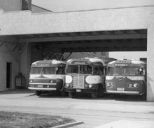|
Trains and Transit
(revised and updated May 2022)
Photo descriptions
and credits at bottom of page.
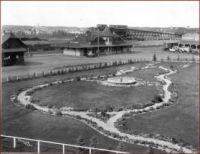 It was when the Canadian Pacific Railway decided to make Red Deer the
divisional point between Calgary and Edmonton in 1908 that the destiny of
downtown Red Deer as the hub of Central Alberta became established. It
was the same year that the wooden bridge across the Red Deer River was
replaced by steel. It was when the Canadian Pacific Railway decided to make Red Deer the
divisional point between Calgary and Edmonton in 1908 that the destiny of
downtown Red Deer as the hub of Central Alberta became established. It
was the same year that the wooden bridge across the Red Deer River was
replaced by steel.
As well as building a new grand station at the head of Ross Street in
1910, the Canadian Pacific built a roundhouse, gravitational coal chutes and other
maintenance facilities to the west of the downtown. A beautiful railroad
park complete with fountain was created east of the station. The
original station was moved south to become a freight shed.
In
1910, the Red Deer-based Alberta Central Railway started construction west of Red Deer
toward Rocky Mountain House for what was planned to be a
transcontinental railway line.
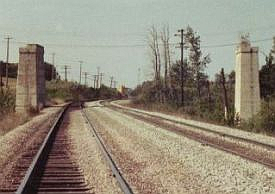
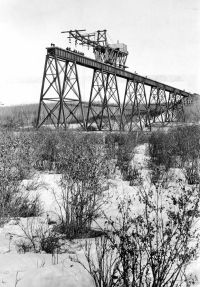 The ACR
crossed the Canadian Pacific Railway and Waskasoo Creek where one of
the bridge abutments still stands along Taylor Drive. The line
connected with the CPR to the south at Forth. To the east, the line
was constructed across Piper Creek along a wooden trestle. A small
station and yards were built farther east in the Mountview area of the town. The ACR
crossed the Canadian Pacific Railway and Waskasoo Creek where one of
the bridge abutments still stands along Taylor Drive. The line
connected with the CPR to the south at Forth. To the east, the line
was constructed across Piper Creek along a wooden trestle. A small
station and yards were built farther east in the Mountview area of the town.
Meanwhile, a large steel trestle that was the second longest of its
type in Alberta at the time was being built across the Red Deer River southwest
of the town.
Unfortunately, the ACR went bankrupt and operation was transferred
to Canadian Pacific which had no plans to maintain the dream of another
transcontinental railroad. The infrastructure built a few months
earlier to Mountview east of its
north-south line was removed and construction west terminated at Rocky
Mountain House.

To make matters worse for the ACR, the Canadian Northern Western Railway started
construction of a competing line originating from near Stettler west to
Red Deer North and Sylvan Lake on
its way to the Brazeau coal fields. That railway had a business
relationship with the Brazeau Colleries and reached Rocky Mountain
House first. The railway had also planned to build a
north-south Calgary-Edmonton line through Red Deer but construction
never occurred.
In 1913, a north-south Calgary-Edmonton line was built 25 miles east of
Red Deer by the Grand
Trunk Pacific Railway through Three Hills, Delburne, Alix, Mirror and
Camrose. It was during that same year that Red Deer became a city.
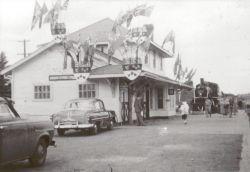 In
1920, the Canadian Northern constructed a bridge across the Red Deer
River from the north as well as a station and other facilities where
the Co-op Plaza shopping mall is now located. However, the bridge was
abandoned in 1941 after several washouts. The railway maintained
service at that location until 1960 with an agreement to use CPR trackage to North Junction. In
1920, the Canadian Northern constructed a bridge across the Red Deer
River from the north as well as a station and other facilities where
the Co-op Plaza shopping mall is now located. However, the bridge was
abandoned in 1941 after several washouts. The railway maintained
service at that location until 1960 with an agreement to use CPR trackage to North Junction.
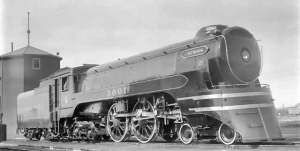 From 1936 to 1955, except
during the early war years, the Canadian Pacific ran a 'high-speed' passenger
train using a specially-designed locomotive for its 'Chinook'
service, the 4-4-4
Jubilee no. 3001. Only five of its class were
ever built and none were preserved. From 1936 to 1955, except
during the early war years, the Canadian Pacific ran a 'high-speed' passenger
train using a specially-designed locomotive for its 'Chinook'
service, the 4-4-4
Jubilee no. 3001. Only five of its class were
ever built and none were preserved.
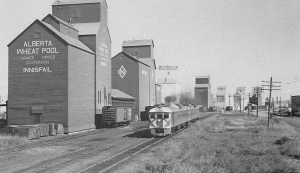
The Jubilee was
replaced by the 'Dayliner' service in 1955 cutting the five-hour trip by
one and a half hours. The 3-per-day Dayliners reached their peak in 1969
with 80,000 passengers carried. Railway passenger service came to an end
in Red Deer in 1985 after 94 years of continuous service. In the
same year, the ACR subdivision to Rocky Mountain House was
officially abandoned although there hadn't been a train on the line
since 1981. Six years later, the downtown railyards were relocated to
the northwest quadrant of the city.
In spite of the railway's early efforts to maintain its hold on
passenger service, sometimes half-heartedly, changes had been occurring
for a few decades
that would require a major shift in thinking. For the most part, the
railways had come to see freight as profitable and passenger service
as not.
Over time as Western Canada developed, trails had become roads, roads had become highways, and a new
freedom of mobility resulted from the development of private
automobiles which had become more affordable in the early 1950s. In part
due to a huge public investment in highway infrastructure, private
and public bus transportation became an attractive alternative to
trains for people who didn't have cars.
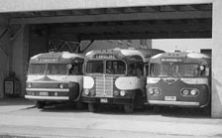 Privately-owned
transit started to develop in Central Alberta in the 1940s and
thrived in the 1950s. The first transit service in Red Deer started
in 1946 by a private operator which was sold in 1956 to another
private operator, Sorensen Bus Lines, which had already established
service connecting several communities. Privately-owned
transit started to develop in Central Alberta in the 1940s and
thrived in the 1950s. The first transit service in Red Deer started
in 1946 by a private operator which was sold in 1956 to another
private operator, Sorensen Bus Lines, which had already established
service connecting several communities.
The Red Deer service became public in 1966 when the city took over
from Sorensen. Red Deer Transit has continued to expand and provide
a high quality of service for a city its size. The service has
expanded into Red Deer
County as well as to Blackfalds and Lacombe. It may become the operator of
an even wider regional network.
As for the future, everything old may become new again, with the
increasing popularity of trails and the renewed interest in
high-speed rail.
Return to Part 1 -
Trails and Trains
Photo descriptions and credits:
Header:
Union bus depot in downtown at Park Hotel Red Deer 1949 (Glenbow
Archives PA-31-27-1)
Canadian Pacific 1910 station, original C&ER 1892 station as freight
shed, park 1912 (Red Deer Archives P3202);
Alberta Central Railway pillars for former bridge over CPR Red Deer
at Forth Junction (Paul Pettypiece 1985);
Construction of the CNWR timber bridge at Burbank over Blindman
River 1911 (Red Deer Archives P7028);
Construction of the ACR Mintlaw steel trestle over Red Deer River
1911 (Red Deer Archives P2631);
Last steam locomotive at Canadian National Railway Red Deer station
1955 (Red Deer Archives P7009);
Jubilee locomotive that led 'The Chinook' between Calgary and
Edmonton 1936 to 1955 (Otto Perry 1936);
CPR Dayliner passes Innisfail elevator row late 1960s (Canadian
Pacific Archives);
Union bus depot in downtown at Park Hotel Red Deer 1949 (Glenbow
Archives PA-31-27-1)
|
